Title: A Step-by-Step Guide to Creating AI-Generated Images
In recent years, the field of artificial intelligence has made tremendous advancements, particularly in the realm of image generation. AI-generated images, also known as generative adversarial network (GAN) images, have gained widespread attention for their ability to create realistic and visually stunning visuals. From creating digital artwork to aiding in medical imaging, AI-generated images have found applications in a wide range of industries.
If you’re interested in exploring the world of AI-generated images and want to learn how to create your own, this step-by-step guide will help you get started.
Step 1: Understand the Basics of GANs
Generative adversarial networks (GANs) are a type of artificial intelligence algorithm that consists of two neural networks: a generator and a discriminator. The generator creates images, while the discriminator evaluates them for authenticity. They work together in a competitive manner, with the generator striving to create images that are indistinguishable from real ones, and the discriminator aiming to differentiate between real and generated images.
Step 2: Choose a Framework or Platform
There are several frameworks and platforms that can be used to create AI-generated images. Some popular options include TensorFlow, PyTorch, and OpenAI’s DALL·E. Choose a framework that best suits your level of expertise and the specific requirements of your project.
Step 3: Collect and Prepare Data
To train a GAN model, you will need a large dataset of images. These images will serve as the basis for the model to learn from and generate new visuals. It’s important to ensure that the dataset is diverse and representative of the types of images you wish to generate. Additionally, data preprocessing techniques, such as resizing images and normalizing pixel values, may be necessary to prepare the data for training.
Step 4: Choose or Build a GAN Model
Depending on your project goals, you may choose to use an existing GAN model or design and train your own. Pre-trained GAN models are available in various frameworks and can be a good starting point for beginners. Alternatively, if you have a specific vision for your AI-generated images, building a custom GAN model may be the best approach.
Step 5: Train the GAN Model
Training a GAN model involves feeding the prepared dataset into the neural network and adjusting its parameters to generate images that closely resemble the input data. This process often requires substantial computational resources, including powerful GPUs, to expedite training. The duration of the training process can vary depending on the complexity of the model and the size of the dataset.
Step 6: Fine-Tune and Evaluate the Model
After the initial training, it’s essential to fine-tune the GAN model and assess its performance. This evaluation may involve qualitative assessment by visually inspecting the generated images, as well as quantitative metrics to measure the model’s fidelity to the training data. Adjustments to the model’s architecture and parameters may be necessary to improve the quality of the generated images.
Step 7: Generate AI-Generated Images
Once the GAN model has been trained and fine-tuned, it’s ready to generate AI-generated images. By inputting random noise or seed images into the generator network, the model can produce novel visuals that closely resemble the training data. Experiment with different input conditions and explore the diversity of images that can be created with the trained GAN model.
Step 8: Use and Share AI-Generated Images
The AI-generated images created with your GAN model can be utilized for a wide range of applications, including art, design, and visual effects. Additionally, sharing your work with the AI community can foster collaboration and feedback, contributing to the advancement of AI-generated imagery as a whole.
In conclusion, creating AI-generated images involves a series of iterative steps, from understanding the fundamentals of GANs to fine-tuning and evaluating the trained models. With the right tools, resources, and dedication, anyone can delve into the fascinating world of AI-driven creativity and produce visually compelling images that push the boundaries of art and technology.
